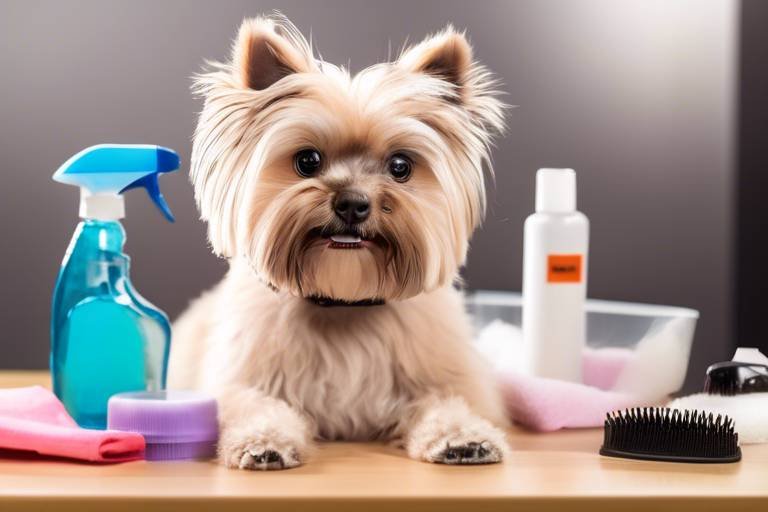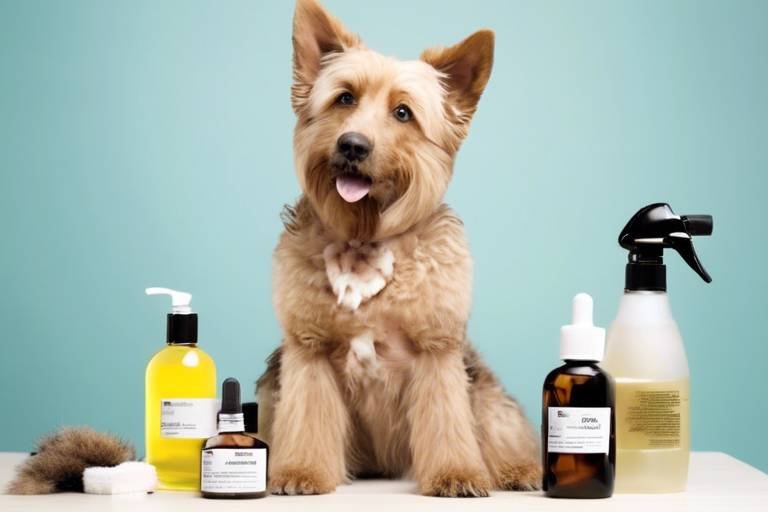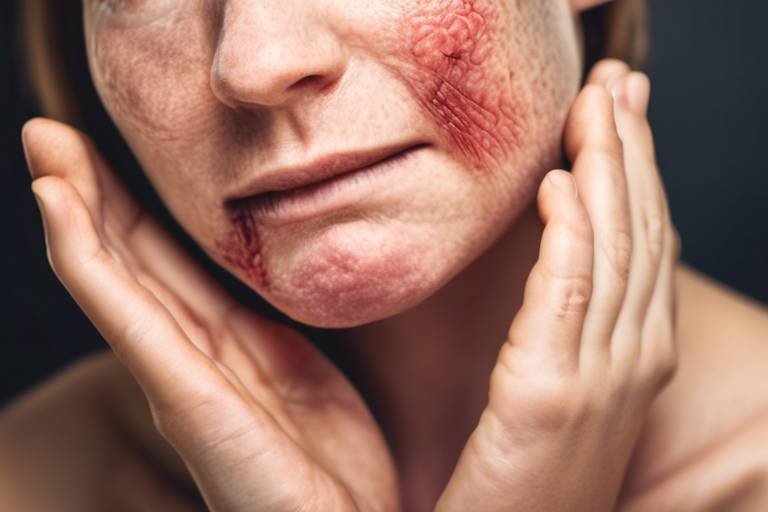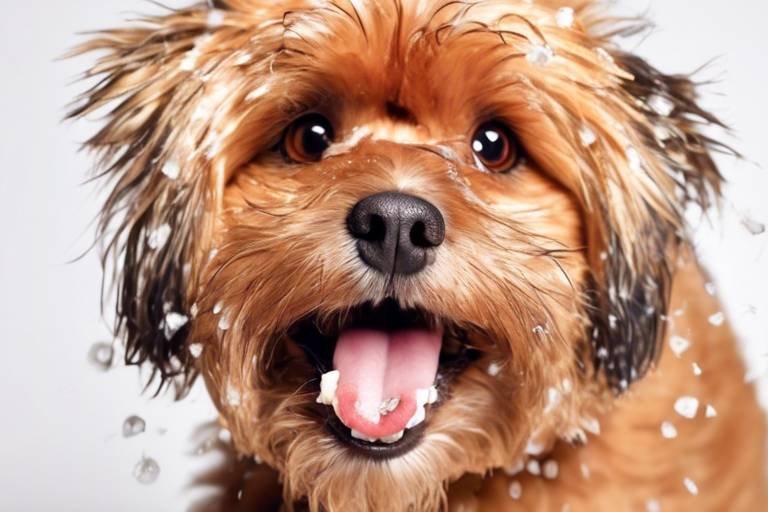The Benefits of Regular Grooming for Pet Lifespan
Regular grooming is more than just a luxury for your furry friends; it's a vital component of their overall health and well-being. Just as we humans benefit from regular check-ups and self-care routines, our pets thrive when they receive consistent grooming attention. This article dives into the numerous benefits that regular grooming can offer, enhancing not only the physical health of your pets but also their emotional well-being. Think of grooming as a health investment—one that pays dividends in the form of a longer, happier life for your beloved companions.
First and foremost, grooming is essential for maintaining improved skin health. When you groom your pet regularly, you're actively removing dirt, debris, and dead hair that can accumulate on their skin. This practice is crucial in preventing skin irritations and conditions, which can lead to discomfort and even serious health issues. A clean coat allows the skin to breathe and function properly, contributing to your pet's overall vitality. Imagine how refreshing it feels to take a shower after a long day; your pet feels the same way after a good grooming session!
Another significant advantage of regular grooming is the enhanced coat condition. A well-groomed pet not only looks good but feels good too! Regular brushing helps distribute natural oils throughout the coat, resulting in a shiny and healthy appearance. This is especially important for long-haired breeds, where a lack of grooming can lead to unsightly tangles and mats.
Speaking of tangles, let's talk about the prevention of matting. Mats can be more than just a nuisance; they can lead to discomfort and painful skin issues if left untreated. Regular grooming sessions are your best defense against mats forming in the first place. By staying on top of grooming, you ensure your pet remains comfortable and pain-free.
Using the right grooming tools is crucial in this process. Brushes, combs, and detanglers can make a significant difference in maintaining your pet's coat. For instance, a slicker brush is perfect for removing loose hair and debris, while a wide-toothed comb can help detangle stubborn knots. Investing in quality grooming tools is like having the right equipment for a DIY project; it makes the job easier and more effective.
It's also essential to recognize the early signs of matting. Look for clumps of hair or areas where the fur feels stiff. By addressing these issues promptly, you can prevent more severe problems down the line. Think of it as catching a small leak in your roof before it turns into a full-blown flood!
Regular grooming sessions also provide pet owners with the opportunity to spot potential health problems early. During grooming, you may notice skin infections, lumps, or even parasites that might otherwise go undetected. This early detection can lead to timely veterinary care, which can be critical in ensuring your pet's long-term health. Just like how regular health check-ups can catch issues before they escalate, grooming serves as a proactive measure for your pet's well-being.
Beyond health benefits, grooming is an excellent opportunity for bonding between pets and their owners. This shared time strengthens the emotional connection and trust between you and your furry friend. Establishing a grooming routine can help your pet feel more comfortable and relaxed during the process, making it a rewarding experience for both of you. It's similar to how a parent might bond with their child during bath time—it's all about creating a positive experience.
Incorporating treats and praise during grooming can encourage good behavior and make future sessions easier and more enjoyable for your pets. Think of it as a way to reward them for their cooperation, reinforcing the idea that grooming is a positive experience rather than a chore.
One of the most practical benefits of regular grooming is its ability to significantly reduce shedding. By removing loose hair, you not only keep your home cleaner but also minimize allergens in the environment. This is particularly beneficial for allergy sufferers who share their lives with furry companions.
Understanding your pet's shedding cycle can help you prepare for seasonal changes. Regular grooming during peak shedding times can help manage the amount of hair in your home. It's like preparing for a storm; if you know it's coming, you can take steps to mitigate its impact.
It's important to note that different breeds have varying grooming needs. Knowing your pet's specific requirements ensures that you provide the best care for their coat and skin health. Whether you have a fluffy Golden Retriever or a sleek Dachshund, understanding their unique grooming needs is key to keeping them healthy and happy.
- How often should I groom my pet? It depends on the breed, but most pets benefit from grooming at least once a week.
- Can I groom my pet at home? Absolutely! With the right tools and techniques, home grooming can be effective and enjoyable.
- What tools do I need for grooming? Basic tools include brushes, combs, nail clippers, and shampoos suitable for your pet's coat type.
- How can I make grooming a positive experience? Use treats, praise, and take your time to make grooming a fun bonding activity.

Improved Skin Health
This article explores how regular grooming can enhance the health and longevity of pets. Discover the various benefits grooming provides, from physical health to emotional well-being.
Regular grooming is not just a luxury for your furry friends; it is a necessity that plays a pivotal role in maintaining their skin health. When you groom your pet, you are actively removing dirt, debris, and dead hair that can accumulate on their skin. This accumulation can lead to skin irritations and various conditions, which can be uncomfortable and even painful for your pet. Just think of grooming as a spa day for your pet, where they can feel refreshed and rejuvenated!
Moreover, grooming helps to stimulate the skin and promote healthy blood circulation. When you brush your pet's coat, you're not just removing the unwanted elements; you're also distributing the natural oils that keep their skin moisturized. This is especially important for pets with longer fur, as their coats can easily trap moisture and dirt, leading to potential skin problems. Regular grooming can help prevent conditions such as:
- Allergies
- Hot spots
- Fungal infections
In essence, a well-groomed pet is a happier pet. By keeping their skin clean and healthy, you're contributing to their overall well-being and comfort. Not to mention, a healthy skin barrier can better protect against external irritants and allergens, reducing the risk of allergic reactions.
It’s also worth noting that grooming provides an opportunity for pet owners to check for any unusual lumps or bumps on their pet’s skin. These could be early signs of health issues that, if left unchecked, could lead to more serious problems down the line. So, during grooming sessions, take a moment to inspect your pet's skin closely; it could be the difference between catching a minor issue early or dealing with a more significant health concern later.
In summary, regular grooming is an essential practice that goes beyond aesthetics. It enhances your pet's skin health, promotes comfort, and allows for early detection of potential health issues. So, the next time you pick up that brush, remember that you’re not just grooming your pet; you’re investing in their health and happiness.
Grooming not only keeps a pet's coat clean but also promotes a shiny and healthy appearance. Regular brushing distributes natural oils, reducing matting and tangles.
Matting can lead to discomfort and skin issues. Regular grooming prevents mats from forming, ensuring your pet remains comfortable and pain-free.
Using the right grooming tools can make a significant difference in preventing matting. Brushes, combs, and detanglers are essential for maintaining a pet's coat.
Recognizing the early signs of matting can help prevent more severe issues. Look for clumps of hair or areas where the fur feels stiff.
Regular grooming sessions allow pet owners to spot potential health problems early, such as skin infections, lumps, or parasites, leading to timely veterinary care.
Grooming provides an excellent opportunity for bonding between pets and their owners. This shared time can strengthen the emotional connection and trust.
Establishing a grooming routine can help pets feel more comfortable and relaxed during the process, making it an enjoyable experience for both pet and owner.
Incorporating treats and praise during grooming can encourage good behavior and make future grooming sessions easier and more enjoyable for pets.
Regular grooming significantly reduces shedding by removing loose hair. This not only keeps homes cleaner but also minimizes allergens in the environment.
Understanding your pet's shedding cycle can help you prepare for seasonal changes. Regular grooming during peak shedding times can help manage the amount of hair in your home.
Different breeds have varying grooming needs. Knowing your pet's specific requirements ensures that you provide the best care for their coat and skin health.
Q: How often should I groom my pet?
A: It depends on the breed, but generally, most pets benefit from grooming at least once a month. Long-haired breeds may require weekly grooming.
Q: Can I groom my pet at home?
A: Absolutely! With the right tools and techniques, you can groom your pet at home. Just ensure you are gentle and patient throughout the process.
Q: What if my pet does not like grooming?
A: Start slowly and use positive reinforcement. Gradually introduce grooming tools and make it a fun experience with treats and praise.

Enhanced Coat Condition
When it comes to our furry friends, their coat is often the first thing we notice. A well-groomed pet not only looks good, but it also feels good! Regular grooming plays a crucial role in maintaining a healthy and shiny coat. Think of grooming as a spa day for your pet; it’s not just about aesthetics, but also about their overall health. When you brush your pet’s fur, you’re not merely removing dirt and loose hair; you're also redistributing those natural oils that keep their coat vibrant and nourished. This process is akin to how we use conditioner after shampooing our hair—it helps to lock in moisture and shine!
Moreover, grooming helps to prevent issues like matting and tangling. Imagine trying to run your fingers through a tangled mess of hair—it’s uncomfortable, right? The same goes for pets. Regular brushing can keep their fur smooth and free from knots, ensuring they remain comfortable and pain-free. Did you know that certain breeds are more prone to matting than others? For instance, breeds like the Shih Tzu and Yorkshire Terrier require more frequent grooming to prevent their luxurious coats from turning into a tangled nightmare.
Another fantastic benefit of grooming is the reduction of shedding. By regularly brushing your pet, you’re not only keeping their coat in top shape but also minimizing the amount of loose hair that ends up on your furniture and clothes. This can be particularly beneficial for allergy sufferers, as less hair means fewer allergens floating around the house. Here’s a quick look at how grooming impacts shedding:
| Grooming Frequency | Expected Shedding Reduction |
|---|---|
| Daily | Up to 90% |
| Weekly | 50-70% |
| Monthly | 20-30% |
In addition to these benefits, grooming sessions can be a wonderful bonding experience between you and your pet. As you brush their coat, you’re not just enhancing their appearance; you’re also creating a sense of trust and comfort. This is especially important for pets that may be anxious or shy. The gentle strokes of a brush can reassure them, making grooming a positive experience rather than a chore. So next time you pick up that brush, remember: it’s not just about keeping your pet looking good; it’s about enhancing their overall well-being!
- How often should I groom my pet? - It depends on the breed and coat type, but generally, regular grooming every few weeks is recommended.
- What tools do I need for grooming? - Basic tools include brushes, combs, and nail clippers. Specialized tools may be needed for certain breeds.
- Can grooming help with my pet's allergies? - Yes, regular grooming can reduce allergens in your home by removing loose hair and dander.
- Should I take my pet to a professional groomer? - If you’re unsure about grooming techniques or if your pet has a complex coat, a professional groomer can be a great help.
Prevention of Matting
When it comes to our furry companions, keeping their coats free from mats is crucial for their comfort and overall health. Matting occurs when fur becomes tangled and clumped together, often leading to skin irritations, discomfort, and even painful lesions. Imagine wearing a sweater that's two sizes too small; that's what matting feels like for your pet! Regular grooming is your best defense against this uncomfortable situation.
One of the first steps in preventing matting is to establish a consistent grooming schedule. Depending on your pet's breed, this could mean grooming daily, weekly, or bi-weekly. Long-haired breeds, like Golden Retrievers or Persian Cats, require more frequent grooming compared to short-haired breeds. A good rule of thumb is to brush your pet's coat at least once a week, but during shedding seasons, you might need to increase this frequency.
Using the right tools is also essential in keeping your pet's coat mat-free. Here are some effective grooming tools:
- Brushes: Slicker brushes are great for removing loose hair and detangling fur.
- Combs: Metal combs can help you get through knots and mats with ease.
- Detanglers: Sprays or conditioners designed to loosen tangles can be lifesavers.
Regular grooming not only helps in preventing mats but also allows you to check for any signs of matting early on. Look out for clumps of hair or areas where the fur feels stiff; these are often early indicators that mats are forming. If you catch them early, you can gently work them out with your fingers or a comb, avoiding the need for more drastic measures like shaving.
In conclusion, preventing matting is all about consistency and the right tools. By incorporating regular grooming into your pet care routine, you can ensure your furry friend remains comfortable, healthy, and happy. After all, a well-groomed pet is not only more pleasant to cuddle with but also less prone to skin issues and discomfort.
- How often should I groom my pet? It depends on the breed. Long-haired pets may need daily grooming, while short-haired ones might do well with weekly sessions.
- What tools do I need for grooming? Essential tools include brushes, combs, and detanglers, tailored to your pet's specific coat type.
- Can matting cause health issues? Yes, severe matting can lead to skin irritation, infections, and discomfort.
- How can I make grooming more enjoyable for my pet? Incorporate treats and praise during grooming sessions to create a positive experience.
Tools for Effective Grooming
This article explores how regular grooming can enhance the health and longevity of pets. Discover the various benefits grooming provides, from physical health to emotional well-being.
Regular grooming helps maintain healthy skin by removing dirt, debris, and dead hair. This practice can prevent skin irritations and conditions, contributing to a pet's overall well-being.
Grooming not only keeps a pet's coat clean but also promotes a shiny and healthy appearance. Regular brushing distributes natural oils, reducing matting and tangles.
Matting can lead to discomfort and skin issues. Regular grooming prevents mats from forming, ensuring your pet remains comfortable and pain-free.
Using the right grooming tools can make a significant difference in the grooming experience for both you and your pet. Think of grooming tools as the magic wands that help you maintain your furry friend's beauty and health. Here are some essential tools that can elevate your grooming game:
- Brushes: Different types of brushes cater to various coat types. For example, slicker brushes are fantastic for removing loose hair and detangling, while bristle brushes are great for smoothing out the coat and distributing natural oils.
- Combs: A good comb can help you get to those tricky spots where mats tend to hide. Wide-toothed combs work wonders for longer hair, while fine-toothed combs are perfect for short-haired breeds.
- Detanglers: If your pet has a long, flowing coat, detanglers can be a lifesaver. These products help to loosen knots and make the grooming process smoother and less painful.
- Clippers: For pets that require regular trimming, investing in a quality clipper can save you a trip to the groomer. Just be sure to learn how to use them safely!
- Shampoo and Conditioner: While not traditional grooming tools, the right shampoo and conditioner can enhance your pet's coat health. Look for products that are specifically designed for pets, as their skin has different pH levels than humans.
When selecting grooming tools, consider your pet's specific needs—such as their coat type and any skin sensitivities. Using the correct tools not only makes the grooming process more effective but also ensures that your pet feels comfortable and relaxed. Remember, grooming should be a positive experience that strengthens the bond between you and your furry friend!
Recognizing the early signs of matting can help prevent more severe issues. Look for clumps of hair or areas where the fur feels stiff.
Regular grooming sessions allow pet owners to spot potential health problems early, such as skin infections, lumps, or parasites, leading to timely veterinary care.
Grooming provides an excellent opportunity for bonding between pets and their owners. This shared time can strengthen the emotional connection and trust.
Establishing a grooming routine can help pets feel more comfortable and relaxed during the process, making it an enjoyable experience for both pet and owner.
Incorporating treats and praise during grooming can encourage good behavior and make future grooming sessions easier and more enjoyable for pets.
Regular grooming significantly reduces shedding by removing loose hair. This not only keeps homes cleaner but also minimizes allergens in the environment.
Understanding your pet's shedding cycle can help you prepare for seasonal changes. Regular grooming during peak shedding times can help manage the amount of hair in your home.
Different breeds have varying grooming needs. Knowing your pet's specific requirements ensures that you provide the best care for their coat and skin health.
Q: How often should I groom my pet?
A: The frequency of grooming depends on your pet's breed and coat type. Long-haired breeds may require grooming several times a week, while short-haired breeds might need it less frequently.
Q: Can I groom my pet at home?
A: Absolutely! With the right tools and a little practice, you can effectively groom your pet at home. Just ensure you’re familiar with their specific grooming needs.
Q: What if my pet doesn't like grooming?
A: Patience is key. Start slowly and use positive reinforcement, such as treats and praise, to make the experience more enjoyable for your pet.
Q: Are there any health benefits to grooming?
A: Yes! Regular grooming can help you spot potential health issues early on, keep your pet's skin healthy, and enhance their overall well-being.
Signs of Matting
Recognizing the early signs of matting in your pet's coat is crucial for maintaining their comfort and health. Matting can occur when fur becomes tangled and knotted, leading to potential skin irritations and discomfort. It's like a bad hair day taken to the extreme! Here are some signs to watch for:
- Clumps of Hair: If you notice small clumps or tufts of hair that feel bunched together, it's a clear sign that matting is starting to occur.
- Stiff Fur: Areas where the fur feels stiff or hard to the touch can indicate that the hair is tangled.
- Skin Irritation: Look for signs of redness or inflammation in areas where the fur is matted, as this can lead to skin infections.
- Difficulty Grooming: If your pet seems uncomfortable or resistant during grooming sessions, it might be because they are experiencing matting.
By being vigilant about these signs, you can take action early, preventing further matting and ensuring your pet remains comfortable. Regular grooming can help you stay ahead of these issues, keeping your furry friend looking and feeling their best.
Q: How often should I groom my pet?
A: The frequency of grooming depends on your pet's breed, coat type, and lifestyle. Generally, long-haired breeds require more frequent grooming, while short-haired breeds may need it less often. Aim for at least once a week for most pets.
Q: Can I groom my pet at home?
A: Yes, many pet owners successfully groom their pets at home. It's essential to have the right tools and to be gentle and patient. If you're unsure, consider consulting a professional groomer for tips.
Q: What tools do I need for grooming?
A: Basic grooming tools include brushes, combs, and detanglers. Depending on your pet's coat type, you might also need specialized tools, such as de-shedding tools or clippers.
Q: What if I find mats in my pet's coat?
A: If you discover mats, try to gently detangle them with your fingers or a comb. For severe matting, it might be best to consult a professional groomer who can safely remove the mats without hurting your pet.
Q: Does grooming help with shedding?
A: Absolutely! Regular grooming helps to remove loose hair and reduces shedding, which can keep your home cleaner and minimize allergens.
Detection of Health Issues
Regular grooming is not just about maintaining your pet's appearance; it plays a crucial role in detecting health issues early on. Imagine grooming as a mini health check-up that you can perform at home. While you’re brushing your furry friend, you have the perfect opportunity to look for any unusual signs that may indicate underlying health problems. This proactive approach can lead to timely veterinary care, which is essential for your pet's long-term health.
During grooming sessions, make it a habit to check for the following potential health concerns:
- Skin infections: Look for redness, swelling, or unusual odors that could indicate an infection.
- Lumps and bumps: Feel for any unusual lumps or growths that weren't there before, as these could be benign or something more serious.
- Parasites: Pay attention to any signs of fleas or ticks, which can lead to significant discomfort and health issues.
- Changes in coat texture: A dull or patchy coat may signal nutritional deficiencies or health problems.
By incorporating these checks into your grooming routine, you not only keep your pet looking great but also ensure that you’re keeping an eye out for anything that might require a vet's attention. Early detection can make a world of difference, much like catching a cold before it turns into the flu. The sooner you identify a problem, the easier it is to treat, and your pet will thank you for it!
In addition to physical checks, grooming also allows you to observe your pet's behavior and mood. If your usually playful pup seems lethargic or irritable during grooming, it might be a sign that something is amiss. Trust your instincts; if something feels off, don't hesitate to consult your veterinarian. After all, our pets rely on us to be their voice!
1. How often should I groom my pet?
The frequency of grooming depends on your pet's breed and coat type. Generally, long-haired breeds require grooming several times a week, while short-haired breeds may only need grooming every few weeks.
2. What tools do I need for grooming?
Basic grooming tools include a brush, comb, nail clippers, and possibly a detangler. The specific tools will depend on your pet's coat type.
3. Can grooming help with my pet's anxiety?
Yes! Regular grooming can help your pet become more accustomed to handling, reducing anxiety over time. Creating a routine and using positive reinforcement can make the experience enjoyable for both of you.
4. What should I do if I find a lump on my pet?
If you discover a lump, it’s important to consult your veterinarian as soon as possible for a proper diagnosis and treatment.

Bonding Time
Grooming goes beyond just keeping your pet looking good; it's a fantastic opportunity for bonding between you and your furry friend. Think of grooming as a shared experience that can deepen your emotional connection. When you take the time to groom your pet regularly, you’re not just enhancing their appearance; you’re also fostering a sense of trust and security. Just like how spending time with friends can strengthen relationships, grooming can create a special bond with your pet. The gentle strokes of a brush and the soothing sounds of clippers can make your pet feel loved and cared for.
Moreover, grooming sessions can be a delightful way to communicate with your pet. As you comb through their fur, you can talk to them in a soft voice, reassuring them that they are safe and loved. This interaction can be incredibly comforting for pets, especially those who may be anxious or shy. Just imagine how much your dog or cat appreciates your attention during these moments! It’s like a mini spa day filled with affection.
To make grooming even more enjoyable, consider establishing a routine. Pets thrive on consistency, and a regular grooming schedule can help them feel more at ease. When they know what to expect, they are less likely to resist the process. You might even find that your pet starts to look forward to grooming sessions as a special time spent with you. Incorporating positive reinforcement, such as treats or praise during and after grooming, can enhance this experience. This not only encourages good behavior but also makes your pet associate grooming with positive outcomes.
In essence, grooming is much more than a chore; it’s a chance to connect, communicate, and create lasting memories with your pet. By investing time in grooming, you're investing in a relationship built on trust and affection. Just like any relationship, the more you nurture it, the stronger it becomes. So, the next time you pick up that brush, remember that you’re not just grooming; you’re bonding!
- How often should I groom my pet? - The frequency of grooming depends on your pet's breed, coat type, and lifestyle. Generally, long-haired breeds require grooming several times a week, while short-haired breeds may only need it once a month.
- What tools do I need for grooming? - Basic grooming tools include brushes, combs, nail clippers, and pet-safe shampoo. The specific tools will vary based on your pet's coat type.
- Can grooming help with my pet's anxiety? - Yes! Regular grooming can help reduce anxiety in pets by providing a calming routine and strengthening the bond between you and your pet.
Creating a Routine
Establishing a regular grooming routine is not just about keeping your pet looking fabulous; it's a vital part of ensuring their overall health and happiness. Just like we humans benefit from a consistent self-care regimen, our furry friends thrive on predictability and routine. Imagine how comforting it is to know what to expect each day—this applies to pets as well!
When you create a grooming schedule, you’re not only helping your pet maintain a clean and healthy coat, but you’re also fostering a sense of security. Think about it: each grooming session can become a special time that you both look forward to. Whether it’s a quick brush after a walk or a more thorough grooming session on the weekend, consistency is key. You can start by setting aside a specific day and time each week dedicated solely to grooming.
Here are a few tips to help you establish this routine:
- Choose the Right Time: Find a time when both you and your pet are relaxed. Early mornings or late afternoons can often be ideal.
- Make it Enjoyable: Incorporate your pet’s favorite treats or toys during grooming. This will create positive associations with the process.
- Be Patient: Especially if your pet is new to grooming, take it slow. Gradually increase the duration of grooming sessions as they become more comfortable.
As you develop this routine, you may notice that your pet becomes more relaxed and cooperative. Over time, grooming can turn into a bonding experience, strengthening the emotional connection between you and your pet. Remember, it’s not just about the physical benefits; it’s about the time spent together that can lead to a happier, healthier pet.
Q: How often should I groom my pet?
A: The frequency of grooming depends on your pet's breed, coat type, and lifestyle. Long-haired breeds may require grooming several times a week, while short-haired breeds may only need it once a month.
Q: What tools do I need for grooming?
A: Essential grooming tools include brushes, combs, nail clippers, and possibly a grooming glove. The right tools will depend on your pet's coat type.
Q: What if my pet doesn't like grooming?
A: Start slowly and make grooming a positive experience with treats and praise. If your pet continues to resist, consider consulting a professional groomer for assistance.
Q: Can grooming help with shedding?
A: Yes! Regular grooming helps remove loose hair and reduces shedding, making your home cleaner and minimizing allergens.
Positive Reinforcement
This article explores how regular grooming can enhance the health and longevity of pets. Discover the various benefits grooming provides, from physical health to emotional well-being.
Regular grooming helps maintain healthy skin by removing dirt, debris, and dead hair. This practice can prevent skin irritations and conditions, contributing to a pet's overall well-being.
Grooming not only keeps a pet's coat clean but also promotes a shiny and healthy appearance. Regular brushing distributes natural oils, reducing matting and tangles.
Matting can lead to discomfort and skin issues. Regular grooming prevents mats from forming, ensuring your pet remains comfortable and pain-free.
Using the right grooming tools can make a significant difference in preventing matting. Brushes, combs, and detanglers are essential for maintaining a pet's coat.
Recognizing the early signs of matting can help prevent more severe issues. Look for clumps of hair or areas where the fur feels stiff.
Regular grooming sessions allow pet owners to spot potential health problems early, such as skin infections, lumps, or parasites, leading to timely veterinary care.
Grooming provides an excellent opportunity for bonding between pets and their owners. This shared time can strengthen the emotional connection and trust.
Establishing a grooming routine can help pets feel more comfortable and relaxed during the process, making it an enjoyable experience for both pet and owner.
When it comes to grooming, plays a crucial role in making the experience enjoyable for both pets and their owners. Think about it: just like humans, pets thrive on praise and rewards. By incorporating treats and affectionate words during grooming sessions, you can encourage your furry friend to behave well and even look forward to the process. For instance, when your dog sits patiently while you brush them, giving them a small treat or a loving scratch behind the ears reinforces that good behavior. This not only makes grooming easier but also builds a sense of trust and comfort between you and your pet.
Moreover, the power of consistency cannot be understated. If your pet begins to associate grooming with positive experiences, they'll be much more likely to cooperate in the future. This creates a cycle of good behavior that benefits both of you. Imagine how much smoother those grooming sessions will be when your pet is eager and excited instead of anxious and resistant!
In addition, consider varying the types of rewards you use. A mix of treats, toys, or even a favorite playtime activity can keep your pet engaged and motivated. This approach not only enhances their grooming experience but also strengthens your bond, making it a delightful routine rather than a chore.
Regular grooming significantly reduces shedding by removing loose hair. This not only keeps homes cleaner but also minimizes allergens in the environment.
Understanding your pet's shedding cycle can help you prepare for seasonal changes. Regular grooming during peak shedding times can help manage the amount of hair in your home.
Different breeds have varying grooming needs. Knowing your pet's specific requirements ensures that you provide the best care for their coat and skin health.
- How often should I groom my pet? It depends on the breed and coat type. Generally, long-haired pets require grooming at least once a week, while short-haired pets may need it less frequently.
- What tools do I need for grooming? Essential tools include brushes, combs, and detanglers. Specific tools may vary based on your pet's breed.
- Can grooming help with my pet's anxiety? Yes! A consistent grooming routine can help reduce anxiety by creating a familiar and comforting experience for your pet.

Reducing Shedding
Regular grooming is an absolute game-changer when it comes to in pets. If you've ever found yourself in a never-ending battle against pet hair on your clothes and furniture, you know just how frustrating it can be! By incorporating a consistent grooming routine, you can significantly decrease the amount of loose hair that ends up on your floors and upholstery. This not only makes your living space more comfortable but also contributes to a healthier indoor environment by minimizing allergens.
One of the primary reasons pets shed is due to their natural hair growth cycles. During certain seasons, particularly spring and fall, many pets experience increased shedding as they transition between their winter and summer coats. This seasonal shedding can seem overwhelming, but with regular grooming, you can manage it effectively. For instance, brushing your pet several times a week during these peak shedding periods can help collect loose hair before it has a chance to scatter throughout your home.
Moreover, grooming sessions provide an excellent opportunity to check for any underlying issues that may contribute to excessive shedding. Factors such as poor nutrition, skin conditions, or stress can all lead to increased hair loss. By keeping a close eye on your pet's coat and skin during grooming, you can catch any potential problems early and consult with your veterinarian if necessary.
To further enhance the shedding reduction process, consider the following tips:
- Choose the Right Tools: Invest in high-quality grooming tools suitable for your pet's coat type. For example, slicker brushes are excellent for removing loose hair from long-haired breeds, while bristle brushes work well for short-haired pets.
- Regular Bathing: Bathing your pet with a gentle shampoo can help remove dead hair and skin cells, making it easier to brush out loose fur during grooming sessions.
- Diet Matters: A balanced diet rich in omega fatty acids can promote a healthy coat and reduce shedding. Talk to your vet about the best food options for your furry friend.
In conclusion, regular grooming is not just about keeping your pet looking great; it's a crucial part of maintaining their overall health and well-being. By reducing shedding through consistent grooming practices, you can create a cleaner, more comfortable home while ensuring your pet stays happy and healthy. Remember, a little effort goes a long way in making life with your furry companion more enjoyable!
Q: How often should I groom my pet to reduce shedding?
A: The frequency of grooming depends on your pet's breed and coat type. Generally, long-haired pets may require grooming several times a week, while short-haired pets may only need grooming once a week.
Q: What tools are best for reducing shedding?
A: The best tools include slicker brushes, deshedding tools, and bristle brushes. Choose tools based on your pet's coat type for optimal results.
Q: Can diet affect shedding?
A: Yes, a poor diet can lead to excessive shedding. Ensure your pet is eating a balanced diet with essential nutrients, including omega fatty acids, to promote a healthy coat.
Q: Is it normal for pets to shed?
A: Yes, shedding is a natural process for pets. However, excessive shedding may indicate a health issue and should be discussed with a veterinarian.
Seasonal Shedding
Ah, the changing seasons! They bring beautiful scenery, but for pet owners, they also signal the dreaded time of . Just like trees lose their leaves in autumn, many pets undergo a significant coat change as the weather shifts. Understanding this natural process is crucial for keeping your home clean and your furry friend comfortable. So, what exactly happens during these shedding seasons?
During spring and fall, many pets shed their undercoats to adapt to the changing temperatures. In spring, they often lose the thick winter coat that kept them warm, while in the fall, they shed lighter fur to make way for a denser coat to prepare for the cold months ahead. This can lead to an explosion of hair around your home, making you feel like you're living in a pet hair wonderland! But fear not; with regular grooming, you can manage this shedding and keep your living space tidy.
Here are some key points to consider regarding seasonal shedding:
- Frequency: Pets may shed more frequently during peak shedding seasons, which can vary by breed and climate.
- Tools: Using a high-quality brush designed for your pet's coat type can significantly reduce loose hair.
- Hydration: Keeping your pet well-hydrated can promote healthier skin and fur, reducing the amount of shedding.
It's also essential to recognize that not all pets shed equally. For instance, double-coated breeds like Huskies and Golden Retrievers will shed more than single-coated breeds such as Beagles or Boxers. Understanding your pet's specific shedding patterns can help you prepare for those hairier times of the year. Regular grooming sessions during these periods can make a world of difference. Not only does it help in managing the hair, but it also promotes a healthy coat and skin.
So, while seasonal shedding may seem like a nuisance, it’s a natural part of your pet's life. Embrace it! With the right tools and techniques, you can turn a potential mess into a manageable routine that benefits both you and your furry friend.
- How often should I groom my pet during shedding season? It’s advisable to groom your pet at least once a week, or more frequently if they are shedding heavily.
- Are there specific brushes for different breeds? Yes, different breeds benefit from different types of brushes. For example, slicker brushes work well for long-haired breeds, while bristle brushes are great for short-haired pets.
- Can diet affect shedding? Absolutely! A balanced diet rich in omega fatty acids can promote a healthy coat and reduce excessive shedding.
Grooming for Different Breeds
When it comes to grooming, one size definitely does not fit all! Just like people have different hair types and styles, pets also have unique grooming needs depending on their breed. Understanding these differences is crucial for ensuring your furry friend looks and feels their best. For instance, a Golden Retriever requires regular brushing to keep their long, flowing coat free of tangles and mats, while a French Bulldog has a short coat that needs less frequent grooming but still benefits from regular cleaning to keep their skin healthy.
Each breed comes with its own set of characteristics that dictate grooming frequency and techniques. Here are some key points to consider:
- Coat Type: Breeds with long, thick fur, like Yorkshire Terriers, may need daily grooming, whereas short-haired breeds, such as Beagles, might only require weekly brushing.
- Shedding Levels: Some breeds, like Shiba Inus, shed heavily during certain seasons, making regular grooming essential to manage loose hair and reduce allergens in your home.
- Skin Conditions: Certain breeds are more prone to skin issues, such as Bulldogs and Pugs, which may need special attention to their skin folds and more frequent baths to prevent irritation.
To help you better understand the grooming requirements for various breeds, here’s a simple table that outlines some popular breeds along with their grooming needs:
| Breed | Coat Type | Grooming Frequency | Special Considerations |
|---|---|---|---|
| Golden Retriever | Long, Thick | 2-3 times a week | Watch for matting; regular baths recommended |
| French Bulldog | Short, Smooth | Once a week | Clean skin folds regularly |
| Yorkshire Terrier | Long, Silky | Daily | Frequent trims may be needed |
| Shiba Inu | Double Coat | Weekly; more during shedding season | Regular brushing helps manage shedding |
| Pug | Short, Smooth | Once a week | Monitor for skin irritation |
Understanding your pet's specific grooming needs not only helps keep their coat healthy but also enhances their overall well-being. Regular grooming can prevent many health issues and ensures your pet remains comfortable and happy. So, whether you’re a proud owner of a fluffy Samoyed or a sleek Dalmatian, tailor your grooming routine to fit their unique needs, and you’ll see the benefits in no time!
Q: How often should I groom my pet?
A: It varies by breed. Long-haired breeds may need daily grooming, while short-haired breeds might only need it weekly.
Q: What tools do I need for grooming?
A: Basic grooming tools include brushes, combs, and nail clippers. Specific breeds may require additional tools like de-shedding tools or dematting combs.
Q: Can grooming help with shedding?
A: Yes! Regular grooming helps to remove loose fur and reduces overall shedding in your home.
Q: Is grooming a good bonding activity?
A: Absolutely! Grooming can strengthen the bond between you and your pet, making it a positive experience for both.
Frequently Asked Questions
- How often should I groom my pet?
The frequency of grooming depends on your pet's breed, coat type, and lifestyle. Generally, long-haired breeds may require grooming several times a week, while short-haired breeds can be groomed every few weeks. Regular grooming helps maintain their coat and skin health.
- What are the benefits of grooming for my pet's health?
Regular grooming can significantly improve your pet's overall health. It helps in detecting skin issues, parasites, or lumps early on, allowing for prompt veterinary care. Additionally, grooming keeps their skin and coat healthy, reducing the risk of infections and irritations.
- Can grooming help reduce my pet's shedding?
Absolutely! Regular grooming removes loose hair and debris, which can drastically reduce shedding in your home. It’s a great way to keep your living space cleaner and minimize allergens, making it beneficial for both you and your pet.
- What tools do I need for effective grooming?
Having the right tools is essential for effective grooming. Basic tools include brushes, combs, and detanglers. Depending on your pet's coat type, you might also need specialized tools like slicker brushes or grooming gloves to keep their coat healthy and mat-free.
- How can I make grooming a positive experience for my pet?
Creating a routine and using positive reinforcement can make grooming enjoyable for your pet. Incorporate treats and praise during grooming sessions to encourage good behavior. Start slowly and gradually increase the duration to help your pet feel more comfortable.
- What should I do if I notice matting in my pet's fur?
If you notice mats forming, it’s important to address them quickly. Use a detangling spray and a proper brush to gently work through the mats. If they are severe, consider seeking help from a professional groomer to avoid hurting your pet.
- How can I recognize signs of matting in my pet?
Look for clumps of hair or areas where the fur feels stiff. If your pet seems uncomfortable or is frequently scratching, these could be signs of matting. Regular grooming can help you catch these issues early before they become a problem.
- Are there specific grooming needs for different breeds?
Yes, different breeds have unique grooming requirements. For instance, breeds with long or curly hair may need more frequent grooming to prevent matting, while short-haired breeds may require less. Researching your specific breed’s needs will help you provide the best care.



















